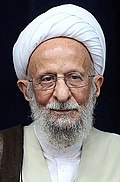2 March and 4 May 2012 | |||
All 290 seats to the Islamic Consultative Assembly 146 seats needed for a majority | |||
|---|---|---|---|
| Turnout | 66.2% [1] | ||
| |||
 |
|---|
| Government of Iran |
The parliamentary election for the 9th Islamic Consultative Assembly, or Majlis, were held in Iran on Friday, 2 March 2012 with a second round on 4 May 2012 in those 65 districts where no candidate received 25% or more of the votes cast. More than 5,000 candidates registered but more than a third were disqualified [9] by the Guardian Council leaving about 3,400 candidates to run for the 290 seat representing the 31 provinces.
Contents
- Background
- Events since the 2008 election
- Electoral system
- Qualifications
- Campaign
- Registration and vetting of candidates
- Political parties and coalitions
- Principlists
- Reformists
- Results
- Analysis
- Turnout
- Notes
- References
- External links
The election has been described by journalists and analysts "as a contest between" Iran's Supreme Leader Ali Khamenei and president Mahmoud Ahmadinejad, [9] with Khamenei supporters winning a large majority of seats. [10] Iranian officials and state media have described the election as a sign of Iranians' trust in the Islamic Republic and a message to the West rejecting pressure over Iran's nuclear program. [10] [11] Although no final election turnout figures were released, [11] state media emphasized that voter turnout was high. [11]
The parliament has "no direct control over key foreign and security policy matters" but some influence over those policies and coming elections. [11] In the wake of the crushing of reformist protest against the 2009 election results, few if any reformist candidates were allowed by the Guardian Council to run. [12] The new parliament was opened on 27 May 2012.









